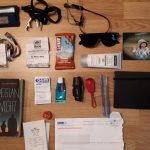
Text
Generated using https://speechnotes.co/
This is the story of how I met my wife. I’m at my wife many years ago in Australia while travelling. We were both travelling actually. I’ve been probably by myself for a couple of months of that stage and I was heading south from karen’s to Alice Springs. My wife was going in the opposite direction she just come up from Adelaide and arrived a day or two before in Alice Springs. It was the day after my birthday. I had plans to go on a trip to lularoe a large rock in the middle of Australia which is a famous tourist destination also a spiritual place for the Aboriginal people in Australia. I was meant to go on the day of my birthday but the people organizing the tour asked me if I’d waited a to allow a couple to go together because of limited spaces. I agreed to do so unfortunately for me my wife was on the tour that next day or my future wife I should say. I remember talking to her already. We exchanged pleasantries said elope she wondered if we’d met before I didn’t think so. I might have been about twelve people on that bus trip it was a 3-day overnight Adventure camping outside under the stars. From Alice Springs to Uluru what’s the full day of driving we got there late in the afternoon just in time to see the sunset over there I’ve never seen Rock. And then that night champs nearby my wife and I are in July channel guide shared stories. The next day we claimed Hillary. I regret doing this night by the time I knew. By the time I knew at the local local Aboriginal people would prefer the tourist did not claim it there was a holy place a special place for them and the thought of anyone claiming and falling it off off The Rock was. Play my youth Cinema ignorance in my ambivalence ignore that and my desire was just to get up the Rock and enjoy the view and hub. And my wife is of a similar mind at that stage two. So we claims me a little bit of head her catching up once in a while we could have fallen into a gigantic together at this stage not ignoring the rest of it but spending extra time with each other. The way she tells that I was annoying her cajoling her to move faster in my mind I was just being encouraging. We jumped again that night playing games singing songs sharing stories with the whole group. And we roll doormat next to each other and as the others kind of fell off to sleep we continue chatting flex tape we drove back to Alice Springs and that night all of us already a large number of the people who paid on the trip together decided for drinks and food and dancing. And it was somewhere in that mix of food drinks and dancing that’s why we had our first kiss.
Questions
How does the text deviate from conventions of written English?
If this story were told in conventional written English I would expect to see it divided into paragraphs. There would also be many commas and more periods. There are several confusing sentences; some running long, others ending abruptly.
What is “wrong” in the text? What is “right”?
I was travelling from ‘Cairns’ not ‘karen’s’, but then I have to admit I sometimes have trouble pronouncing Cairns the way the Australians do. It reads as ‘she just come up’, when I think I said ‘she had just come up’. This stands out for me more than some of the other mistakes as it reminds me of childhood mockery and the ways in which we would make fun of each other, imitating someone who did not speak the language well. ‘Uluru’, which I would imagine is a difficult word for a software like this to get right, is captured correctly the second time I spoke it and incorrectly the first (lularroe) and third time (Hillary’).
In the text it states ‘unfortunately for me’, when I in fact said ‘fortunately for me’. However, I think in this context most people reading the text would themselves autocorrect and not spend time wondering why I said ‘unfortunately’.
‘We exchanged pleasantries said elope’ – Here the software wrote ‘elope’ instead of ‘hello’. This dramatically changes our first interaction from something rather mundane into a wild romance where we decided to elope the moment we laid eyes on each other.
What are the most common “mistakes” in the text and why do you consider them “mistakes”?
The most common mistakes are the unpolished sentences which lack punctuation. Pacing is a big part of storytelling. Punctuation and sentence structure (e.g., varying the length) help adjust the pacing. I tried to insert periods when telling my story, but I also forgot to do so on several occasions.
Problems with prepositions is another common mistake. Prepositions are missed or mistaken for something else (e.g., “by myself for a couple of months of that stage” and “bit of head her”). Prepositions help structure sentences and help make clear the relationships between different objects in a sentence.
There are also several words misheard and written incorrectly (e.g., ‘claimed’ instead of ‘climbed’, ‘Play my youth Cinema ignorance’ instead of ‘in my youthful ignorance’). It’s easy enough for the reader to guess it should be climbed instead of claimed, but in the other example even I had trouble figuring out what I had said.
As to why I consider these things mistakes…I don’t always write great sentences but I like to think I have an appreciation for a well written one. A well written sentence helps the story flow and does not draw too much attention to itself. Badly written sentences are jarring and distance the reader from the story. Is the simpler answer as to why I consider these things mistakes because I have been conditioned to do so. It is part of my job to perform quality reviews of documents and it is something I have learned to do over the course of many years of schooling and working. Maybe it is a form of elitism and I am signaling by recognizing these mistakes that my place is with the ‘intellectual class’.
What if you had “scripted” the story? What difference might that have made?
The story I told was not entirely unscripted, although I had no notes. I have told this story or versions of this story before, sometimes by myself and sometimes together with my wife. But I have not told this story for a while and so I am rusty. However, I think the biggest factor in telling this story aloud here is that I did not have an audience to respond to. It’s a different experience when I am reacting to whatever audience I am sharing this story with. I’ll emphasize different things. I’ll slow down and speed up in different places. I suppose I had some thought that this story is going out to my classmates and instructor, but there was none of the feeling of intimacy that comes with sharing a story face to face.
Given the fact that I have told versions of this story on several occasions before I would have expected to be more assured, confident and polished when telling it, but I did not feel that way. If I had scripted the story I would have felt more assured, confident and polished. As someone who has done a fair bit of presenting I tend to think of a script as a safety net. It is there to catch you when you slip and bounce you back to where you want to be. Knowing you have a safety net you feel free to take chances that you might not otherwise do and embellish the original story or invite audience participation.
In what ways does oral storytelling differ from written storytelling?
When listening to the Orson Welles’ audio clip from ‘Julius Caesar’ it occurs to me that what we think of as powerful oration often makes use of repetition and callback; a sense of building to a crescendo. There’s an understanding that the oral storyteller only has an audience’s attention for a short time span and that in order to sustain their attention they must create a sense that they are moving towards something; a satisfying pay off. It could be argued that there are similar expectations in written storytelling, the difference being that more room or time is given to get to the pay off. The repetition and callback in oral storytelling make it easier for the listener to follow along and keep track of where the story is going.
Reference
Welles, O. (1938). Mark Anthony’s Oration. ‘Julius Caesar’ (Mercury Theatre Company [Audio file]. Retrieved from URL:https://ia902707.us.archive.org/15/items/OrsonWelles-MercuryTheater-1938Recordings/MercuryTheater38-09-11JuliusCeasar.mp3
Read more : Task 4: Manual Scripts








